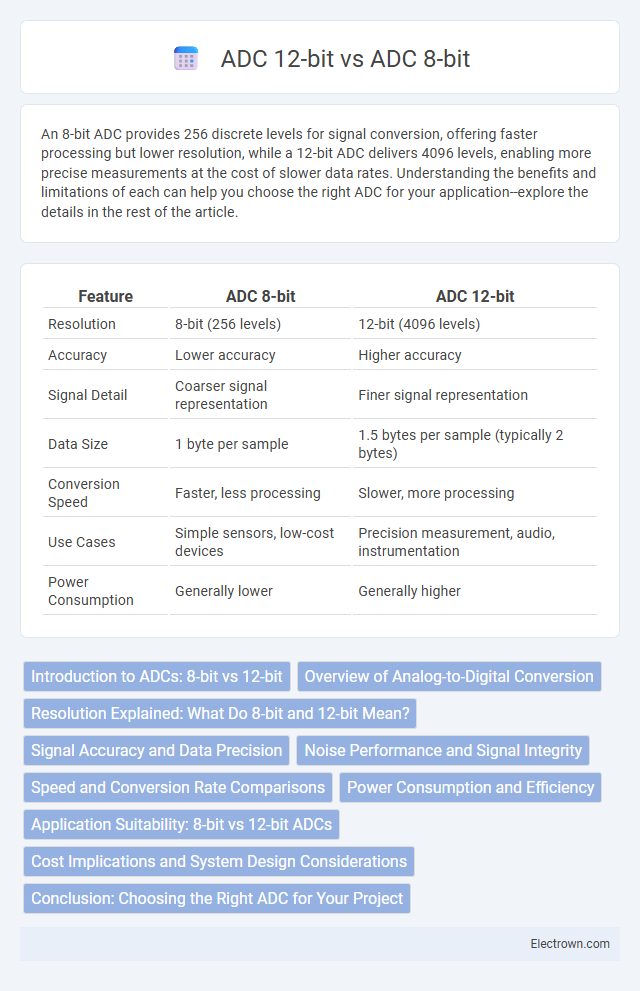An 8-bit ADC provides 256 discrete levels for signal conversion, offering faster processing but lower resolution, while a 12-bit ADC delivers 4096 levels, enabling more precise measurements at the cost of slower data rates. Understanding the benefits and limitations of each can help you choose the right ADC for your application--explore the details in the rest of the article.
Table of Comparison
| Feature | ADC 8-bit | ADC 12-bit |
|---|---|---|
| Resolution | 8-bit (256 levels) | 12-bit (4096 levels) |
| Accuracy | Lower accuracy | Higher accuracy |
| Signal Detail | Coarser signal representation | Finer signal representation |
| Data Size | 1 byte per sample | 1.5 bytes per sample (typically 2 bytes) |
| Conversion Speed | Faster, less processing | Slower, more processing |
| Use Cases | Simple sensors, low-cost devices | Precision measurement, audio, instrumentation |
| Power Consumption | Generally lower | Generally higher |
Introduction to ADCs: 8-bit vs 12-bit
Analog-to-Digital Converters (ADCs) transform analog signals into digital data, with resolution defined by bit depth impacting precision. An 8-bit ADC provides 256 discrete levels, suitable for applications requiring lower accuracy and faster processing. A 12-bit ADC offers 4096 discrete levels, delivering higher resolution crucial for detailed signal analysis and improved measurement accuracy.
Overview of Analog-to-Digital Conversion
Analog-to-Digital Converters (ADCs) transform continuous analog signals into discrete digital values for processing, with bit depth determining the resolution of this conversion. An 8-bit ADC produces 256 discrete levels (2^8), which results in lower resolution and greater quantization error compared to a 12-bit ADC offering 4,096 discrete levels (2^12) for finer signal detail. Choosing your ADC resolution affects the accuracy and quality of digital representation critical in applications like audio processing, instrumentation, and control systems.
Resolution Explained: What Do 8-bit and 12-bit Mean?
An 8-bit ADC provides 2^8, or 256 discrete levels of signal measurement, while a 12-bit ADC offers 2^12, equating to 4,096 levels, allowing for finer detail and greater accuracy in analog-to-digital conversion. The resolution reflects how precisely the ADC can represent the input voltage, with 12-bit ADCs capturing smaller signal variations compared to 8-bit ADCs. Higher bit-depth in ADCs translates to improved signal fidelity and reduced quantization error, critical in applications requiring precise measurements.
Signal Accuracy and Data Precision
An 8-bit ADC provides 256 discrete signal levels, resulting in lower resolution and reduced signal accuracy compared to a 12-bit ADC, which offers 4096 levels for finer quantization. The increased bit depth of a 12-bit ADC significantly enhances data precision by minimizing quantization error and enabling more detailed representation of analog signals. Applications requiring precise measurements, such as instrumentation and medical devices, benefit from the superior signal fidelity and measurement granularity of 12-bit ADCs over 8-bit counterparts.
Noise Performance and Signal Integrity
An 8-bit ADC offers lower resolution, resulting in higher quantization noise and reduced signal integrity compared to a 12-bit ADC, which provides finer granularity and improved accuracy in signal representation. The 12-bit ADC's enhanced resolution significantly reduces noise floor, enabling better differentiation of small signal variations and preserving signal fidelity. Consequently, applications demanding precise measurements and low noise, such as instrumentation and high-quality audio acquisition, benefit greatly from 12-bit ADCs over their 8-bit counterparts.
Speed and Conversion Rate Comparisons
An 8-bit ADC offers faster conversion speeds due to its lower resolution, often achieving conversion rates up to several megasamples per second, making it ideal for applications where speed is critical. In contrast, a 12-bit ADC provides higher resolution but typically operates at slower speeds, with conversion rates generally ranging from hundreds of kilohertz to low megahertz, suitable for precise measurements requiring more detailed data. Your choice between an 8-bit and 12-bit ADC should balance the need for speed versus accuracy depending on the specific application requirements.
Power Consumption and Efficiency
An 8-bit ADC typically consumes less power than a 12-bit ADC due to its simpler architecture and lower resolution requirements, making it more suitable for low-power applications. A 12-bit ADC offers higher precision by providing 4096 quantization levels compared to 256 levels in an 8-bit ADC, but this increased resolution often leads to higher power consumption and reduced efficiency in battery-powered devices. Optimizing power efficiency involves balancing resolution demands with the specific application's accuracy needs, often favoring 8-bit ADCs in low-power environments and 12-bit ADCs where precision is critical despite higher energy costs.
Application Suitability: 8-bit vs 12-bit ADCs
8-bit ADCs provide faster conversion speeds with lower power consumption, making them ideal for applications like simple sensors, audio sampling, and digital signal processing where precision demands are moderate. 12-bit ADCs deliver higher resolution and better accuracy, suitable for precision measurement tasks such as medical instrumentation, industrial control systems, and high-quality audio recording. Selecting between 8-bit and 12-bit ADCs depends on balancing the trade-off between resolution, speed, and power consumption based on application requirements.
Cost Implications and System Design Considerations
8-bit ADCs generally offer lower cost and simpler system integration, making them suitable for budget-sensitive applications with less stringent accuracy requirements. In contrast, 12-bit ADCs provide higher resolution and better signal fidelity, which can increase overall system cost due to more complex analog front-end design and processing power demands. System designers must balance the trade-offs between cost, precision, and data throughput when selecting between 8-bit and 12-bit ADCs to meet application-specific performance criteria.
Conclusion: Choosing the Right ADC for Your Project
Selecting between an 8-bit and a 12-bit ADC depends on your project's precision and resolution requirements. An 8-bit ADC offers faster conversion speeds and lower power consumption, ideal for applications with less stringent accuracy needs. Your choice should prioritize a 12-bit ADC when higher resolution and finer signal detail are critical to ensure optimal performance and data quality.
ADC 8-bit vs ADC 12-bit Infographic

 electrown.com
electrown.com